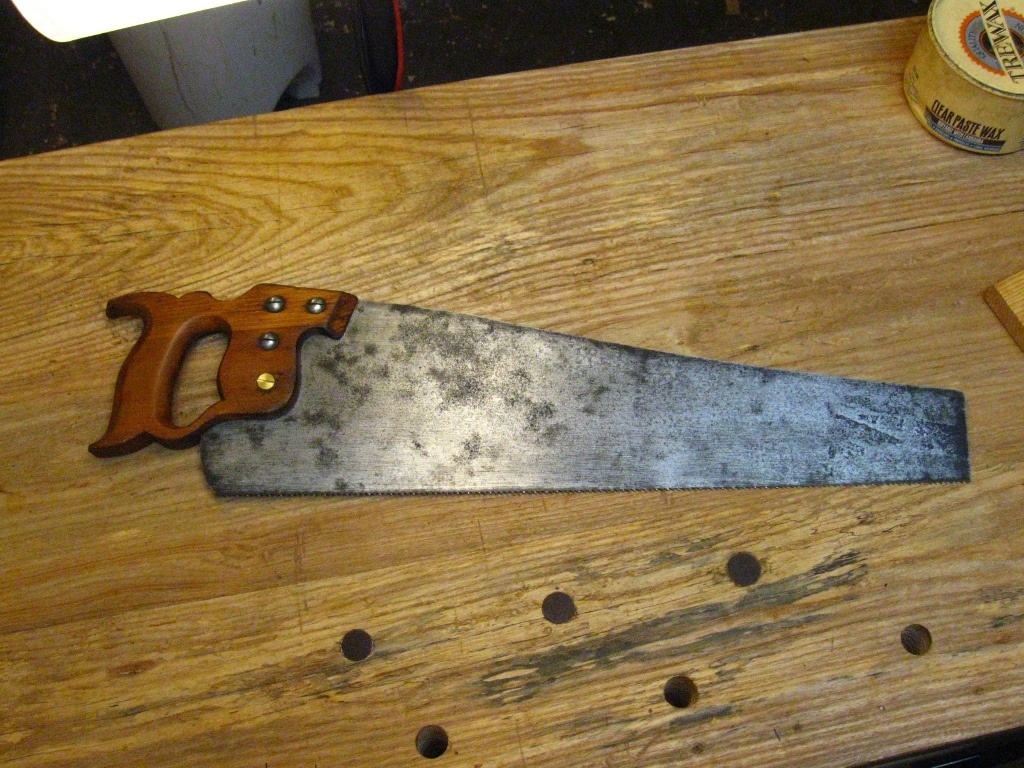This project covers cleaning and restoring an old handsaw – worth about $5 at a yard sale – and turning it into a useful tool again.
Handsaw Basics
Handsaws come in two basic forms: handsaw and backsaw. Backsaws are (typically) short saws with very thin blades and fine teeth with a rigid steel or brass back to stiffen their thin blades. They are mainly used when a very accurate cut is needed such as when cutting dovetail joints.
Handsaws are like the one pictured in this guide, blades of spring steel with wooden handles attached. They come in a variety of sizes from about 20″ to over 30″. They are generally used for cutting stock (boards) to the proper width and length. Saws on the shorter end of the scale are often referred to as panel saws; they make excellent toolbox saws and are easier to use in tight spaces or when sawing at an odd angle. However being shorter they cut less wood per stroke than their longer cousins.
Both backsaws and handsaws can have teeth that are filed for either rip cuts or cross cuts. Rip saws are used for cutting with the grain the wood (along the length of the board) and crosscut saws are for cutting across the grain of the board. Rip teeth are shaped like tiny chisels and scoop up the wood grain as they cut, producing sawdust made of tiny curly shavings. Crosscut teeth are shaped like little knives; they sever the wood fibers as they cut and produce a more powdery saw dust. Tooth size is measured in teeth or points per inch (TPI or PPI). The higher the TPI the smaller the teeth. Other things being equal, a saw with finer teeth will cut the same board slower than a saw with coarser teeth but will leave a better surface.
A crosscut handsaw between 7-10 TPI is a very good all-around saw and does a good job on boards around one inch thick, leaving a decent surface but cutting quickly. For rip saws, between 5-7 TPI is a good all-around size for working with one-inch boards.
Why Bother?
Modern saws found at the big-box home centers usually have induction-hardened teeth that can’t be sharpened – they are meant to be thrown away when dull. They also have thick heavy blades, blocky plastic handles and teeth that seem to be engineered to do a bad job at both rip- and cross-cuts. They are really designed and marketed towards users who won’t bother to learn how to saw properly and can’t be bothered to maintain their tools.
Vintage saws from the turn of the last century, though, are literally the tools that built the U.S. These are tools that were made for skilled craftsmen to use and care for. They are fully user-serviceable and with the right set of files can be easily converted or tweaked to any use you have for them. With a little patience and practice to learn proper sawing technique, using a quality handsaw can actually be much faster than setting up a power saw for many types of cuts, not to mention safer, cleaner and quieter.
Vintage handsaws, and hand tools in general, made in the US from about 1880 to the 1950’s are very common at online auction sites, garage sales and thrift stores. Aside from a few collectible brands and models most can be had for a fraction of what similar-quality new tools go for. With just a little TLC in the workshop these old tools can be brought back to life.
Well-made vintage handsaws have many features not found on modern saws, except through a few specialty makers, that really improve the user experience. For starters they have much nicer handles made from fine hardwoods and shaped to be comfortable for working with all day. Many are also quite beautiful, especially compared to the blocky plastic handles on modern hardware-store saws. Vintage saws frequently have thinner, lighter blades which are often taper-ground. A taper-ground blade is thicker at the tooth line than it is at the top, reducing the drag on the blade as it moves through the wood making it easier to use for longer periods of time.
Common Problems & Wear and Tear
Many old tools show many signs of use and abuse in their long histories, some more than others. Common damage to old saws includes missing saw nuts or medallions, chipped horns on the handle, cracked or split handles, broken teeth, kinked blades and of course rust. Most of these problems are fixable or can be worked around.
Saws also show regular wear that’s not the result of abuse. The most common is naturally a narrowing of the blade from sharpening over the years. Once a blade gets too narrow it loses too much rigidity and can easily bend or kink while in use. A full length (>26″) handsaw that has become too narrow can be shortened to panel-saw length (~21″) and gain many years of life, which is exactly what I show in this guide.
What’s Ahead
This guide will cover the basics of finding a good vintage saw in the open market; how to clean and refinish the handle; how to clean and polish the blade; and an introduction to saw sharpening. Check the conclusion for information on where to find tools and equipment as well as links to detailed tutorials on saw sharpening.


